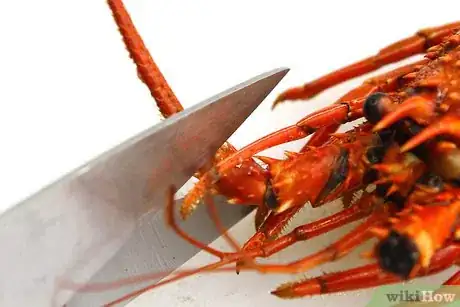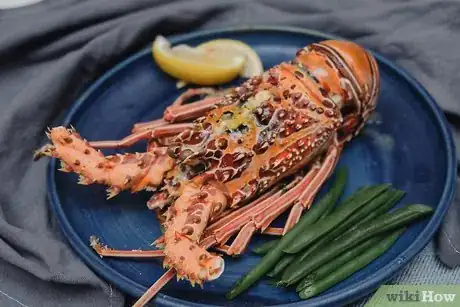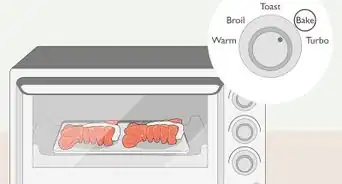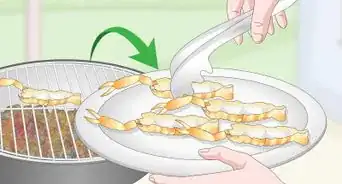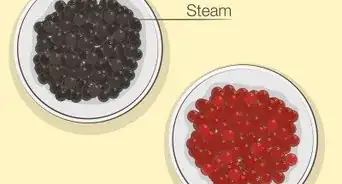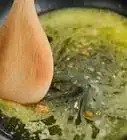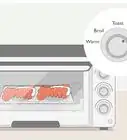This article was co-authored by wikiHow Staff. Our trained team of editors and researchers validate articles for accuracy and comprehensiveness. wikiHow's Content Management Team carefully monitors the work from our editorial staff to ensure that each article is backed by trusted research and meets our high quality standards.
There are 8 references cited in this article, which can be found at the bottom of the page.
The wikiHow Culinary Team also followed the article's instructions and verified that they work.
This article has been viewed 346,442 times.
Learn more...
Boiling is the most popular and simple way of preparing lobster. Although it began as a poor man's food in the early 19th century, public opinion has shifted through the years and now lobster is now a prized dish around the world, especially in the American northeast.
Ingredients
- 4 live 1.5 pounds (0.68 kg) lobsters
- 12 tablespoons (180 ml) sea salt per 1 gallon (3.8 L) of water
- 2⁄3 cup (160 ml) melted butter
- 1 lemon
Steps
Cooking Your Lobster
-
1Purchase 4 live lobsters from your local grocery store. Ask employees where the lobster is sourced from—if the store is extremely close to the source, the lobster likely be a bit fresher. Otherwise, location isn't a huge deal. Wrap them in a damp (but not wet) newspaper. Store them in a container or bag with 1 frozen gel pack. Place them on the bottom shelf of your fridge to avoid cross contamination for a maximum of 36 to 48 hours.[1]
- Claws should be clean and free from scratches.
- Leave the rubber bands on their claws until you submerge them in water—their claws are strong and can cause injury.
- Remember: the farther the sources from their market, the less effect distance has on quality.
-
2Fill a 6 gallons (23 L) stockpot with 4 to 5 gallons (15 to 19 L) of water. This should hold about 6 to 8 pounds (2.7 to 3.6 kg) of lobster. As a rule of thumb, it's better to have too much water than to overcrowd the pot with too much lobster.[2]Advertisement
-
3Add 12 tablespoons of salt per 1 gallon (3.8 L) of water. Salt increases the boiling point of water. This means your water will come to a more steady boil than it would without salt, which is ideal for rolling boils.[3]
- For best results, use sea salt.
-
4Add 1 sprig of thyme, 2 bay leaves, and the juice of 1 lemon into the water. Cut the lemon in half and squeeze the juice into a bowl. You can also purchase lemon juice from the store—a medium-sized lemon is about 1⁄4 cup (59 ml) of lemon juice. Afterward, pour the juice into the stockpot along with the other ingredients.[4]
- This step is ideal if you prefer a broth (meat cooked with vegetable chunks and water) to a brine (meat cooked in high-concentration salt water).
- If you plan to eat your lobster with melted butter, you can skip this step.
-
5Bring the water to a full rolling boil. A rolling boil is when the water does not stop boiling when you stir the water. Place the pot on an element and set it to the highest heat possible. Once you notice consistent bubbling, you can begin adding your lobsters.[5]
- Always keep a rolling boil—it will ensure the water will boil even after the lobster is put into the pot, reducing the temperature of the water momentarily.
-
6Hold the lobsters by the tail with your tongs and put them in the water. Gently dip them into the water one at a time, always placing them headfirst. Submerge them as fast as possible, but take care not to splash any water. Afterward, clamp the lid onto the pot and turn on your timer.[6]
- Remove the rubber bands prior to submerging your lobster in the boiling water. Grab the lobster by the back of the carapace (the upper hard shell) while doing this.
- Submerge the lobsters in quick succession to ensure they all receive equal cooking time.
-
7Boil 8 minutes for each 1 pound (0.45 kg) of lobster. For example, for 4 live 1.5 pounds (0.68 kg) lobsters, leave the lobsters in the pot for 43 to 48 minutes. Follow the boiling guide above for different weights.[7]
- Keep the lid clamped tightly to the pot with no openings in the seal.
- Gently stir the lobsters with your tongs halfway through the allotted cooking time.
-
8Check whether the lobsters are cooked after the allotted cooking time. You should notice the shells turning bright red (uncooked lobster is charcoal in color). To check if they're properly cooked inside, crack open the region where the carapace reaches the tail using scissors. If it's properly cooked, the meat will be opaque and firm.[8]
- Tug on an antenna—if the lobster is fully cooked, it will come off easily
- If you notice loose and translucent meat, the lobster isn't cooked. Boil it for another 3 to 5 minutes and then check again. Continue this process until the lobster is completely cooked through.
Draining and Serving the Lobster
-
1Drain your lobsters in a colander. Remove your lobsters from the water using tongs and place them in a colander sitting underside up on a clean work surface. Gently shake it to the left and right to get rid of initial water.[9]
- Place paper towel underneath your colander to catch drainage.
-
2Remove the tips of each lobster claw. Use scissors or a kitchen knife and take care not to cut yourself by aiming the pointed edge of your tool away from you. Cutting the tips prevents your lobsters from becoming waterlogged and improves the draining process.[10]
- Grasp the lobster firmly and split the tail along the length using a knife. This also improves drainage.
-
3Melt 2⁄3 cup (160 ml) melted butter in a heavy saucepan on your stovetop. Keep an eye on the butter and wait for it to begin melting. Once it is approximately ¾ melted, stir it with a wooden spoon until it finishes melted.[11]
- Most sticks of butter are around 1⁄2 cup (120 ml).
- You can also cut your butter into small 1 inch (2.5 cm) pieces and melt them in a microwave on medium-low power or defrost. Check on it every 10 to 15 second until it's nearly melted. Now, remove it and stir it to complete the melting process.
-
4Serve your lobster with your choice of sides. Pour your melted butter over the lobster and enjoy it with your choice of sides. Common choices include lemon wedges, corn on the cob, fresh green beans, and asparagus.
- Use a lobster cracker to get through your lobster shells and reach the meat. You can also use your hands in combination with a lobster fork to dig into the smaller crevices.
- Store your lobster in the refrigerator for 3 to 4 days at most. In the freezer, lobster lasts for 2 to 3 months. After de-thawing frozen lobster, you can store it in the refrigerator for another 3 to 4 days prior to cooking.[12]
- Lobster should be thrown away if it's left at room temperature for more than 2 hours. Signs of bad lobster include a slimy texture and a sour smell. Don't taste lobster before looking for these signs.
Community Q&A
-
QuestionI'm boiling 2 live chicken lobsters @ 1.25 lbs each. So do I boil for 8 minutes each (which is 16 minutes) or 8 minutes total for both?
 Community AnswerIf your pot is big enough to cook both of them at once, then it will only take 8 minutes when the pot is boiling.
Community AnswerIf your pot is big enough to cook both of them at once, then it will only take 8 minutes when the pot is boiling. -
QuestionI have different sizes of lobsters. Should I put the big one in first and wait a few minutes to put the smaller ones in?
 Community AnswerIf you can, you should just use the small ones. If you can't, just put them in at the same time. Once the small ones are done, take them out, but keep the larger one in for a teensy bit longer.
Community AnswerIf you can, you should just use the small ones. If you can't, just put them in at the same time. Once the small ones are done, take them out, but keep the larger one in for a teensy bit longer. -
QuestionFor how long do four 1.5-pound lobsters need to be boiled?
 Community AnswerIt will depend on how well done you want your lobsters and what you're using them for. If you just want to eat sweet, fresh lobster, bring a large pot of water to a rolling boil (I use a canning pot), add the lobsters head-first as quickly as you can, and let the water return to a boil. When they turn completely red (Maine lobsters) -- usually about 10 minutes -- they're done. Lift them out of the water by the body, allowing excess water to drain back into the pot. Allow to cool for a few minutes, then turn them over and cut through the bottom of the tail carapace. Using a hefty fork, pull the tail meat out from the end of the tail.
Community AnswerIt will depend on how well done you want your lobsters and what you're using them for. If you just want to eat sweet, fresh lobster, bring a large pot of water to a rolling boil (I use a canning pot), add the lobsters head-first as quickly as you can, and let the water return to a boil. When they turn completely red (Maine lobsters) -- usually about 10 minutes -- they're done. Lift them out of the water by the body, allowing excess water to drain back into the pot. Allow to cool for a few minutes, then turn them over and cut through the bottom of the tail carapace. Using a hefty fork, pull the tail meat out from the end of the tail.
Things You'll Need
- 4 live 1.5 pounds (0.68 kg) lobsters
- Frozen gel pack
- 6 gallons (23 L) stockpot
- 2 or 3 tablespoons (30 or 44 ml) salt
- 1⁄2 cup (120 ml) melted butter
- 1 sprig of thyme
- 2 bay leaves
- 1 lemon
- Bowl
- Scissors
- Kitchen knife
- Timer
- Heavy saucepan
- Wooden spoon
Warnings
- Always keep lobsters alive until they are cooked. Their flesh quickly deteriorates following death. [13]⧼thumbs_response⧽
References
- ↑ http://www.foodrepublic.com/2012/06/12/how-to-store-live-lobsters-before-the-delicious-end-result/
- ↑ https://www.foodnetwork.com/recipes/boiled-lobsters-recipe-1942080
- ↑ https://van.physics.illinois.edu/qa/listing.php?id=1457
- ↑ http://www.lobsterhelp.com/boiling-lobster.html
- ↑ http://www.lobsterfrommaine.com/boiling-lobster/
- ↑ https://www.foodnetwork.com/recipes/boiled-lobsters-recipe-1942080
- ↑ http://www.lobsterfrommaine.com/boiling-lobster/
- ↑ https://www.foodnetwork.com/recipes/boiled-lobsters-recipe-1942080
- ↑ https://www.foodnetwork.com/recipes/boiled-lobsters-recipe-1942080
About This Article
To boil a lobster, first set the live lobster on a cutting board and place the tip of a chef’s knife 1 inch (2.5 cm) above the first striation. Hold the lobster down with your free hand and quickly insert the knife straight down through the lobster. Bring the blade down so it’s parallel to the cutting board to humanely kill the lobster. Then, bring a large pot of salted water to a boil. Drop the lobster into the boiling water, wait for the water to start boiling again, and put the lid on. Boil a 1-pound (½-kg) lobster for 10 minutes, adding 3 minutes for each additional pound (½ kg). Finally, drain the lobster and serve with melted butter. Keep reading to learn how to drain the lobsters and prepare them for serving!
